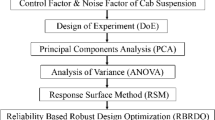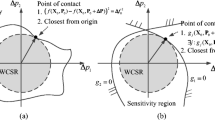Abstract
The current research of complex nonlinear system robust optimization mainly focuses on the features of design parameters, such as probability density functions, boundary conditions, etc. After parameters study, high-dimensional curve or robust control design is used to find an accurate robust solution. However, there may exist complex interaction between parameters and practical engineering system. With the increase of the number of parameters, it is getting hard to determine high-dimensional curves and robust control methods, thus it’s difficult to get the robust design solutions. In this paper, a method of global sensitivity analysis based on divided variables in groups is proposed. By making relevant variables in one group and keeping each other independent among sets of variables, global sensitivity analysis is conducted in grouped variables and the importance of parameters is evaluated by calculating the contribution value of each parameter to the total variance of system response. By ranking the importance of input parameters, relatively important parameters are chosen to conduct robust design analysis of the system. By applying this method to the robust optimization design of a real complex nonlinear system-a vehicle occupant restraint system with multi-parameter, good solution is gained and the response variance of the objective function is reduced to 0.01, which indicates that the robustness of the occupant restraint system is improved in a great degree and the method is effective and valuable for the robust design of complex nonlinear system. This research proposes a new method which can be used to obtain solutions for complex nonlinear system robust design.
Similar content being viewed by others
References
WEN Bangchun, ZHOU Zhicheng, HAN Qingkai, et al. Important role of products design of modern machinery in the research and development of new products-study on the threefold synthesis method “dynamic design, intelligent design and partial virtual design” face to products generalization quality[J]. Chinese Journal of Mechanical Engineering, 2003, 39(10): 43–52. (in Chinese)
ZHANG Jian, GU Peihua, BAO Nengsheng, et al. Analytical robust design of non-linear mechanical systems[J]. Journal of Mechanical Engineering, 2009, 45(10): 207–215. (in Chinese)
PIET W, GIELEN G, SANSEN W. Symbolic network analysis methods for practical analog integrated circuits: A survey[J]. IEEE Transactions on Circuits and Systems II: Analog and Digital Signal Processing, 1998, 45(10): 1331–1341.
YAN Changhao, WANG Shengguo, ZENG Xuan. A new method for multiparameter robust stability distribution analysis of linear analog circuits[J]. IEEE/ACM International Conference on Computer-Aided Design, Digest of Technical Papers, 2011, 6105363: 420–427.
LOCKE J C W, MILLAR A J, TURNER M S. Modelling genetic networks with noisy and varied experimental data: the circadian clock in Arabidopsis thaliana[J]. Journal of Theoretical Biology, 2005, 234(3): 383–393.
ALVES R, SAVAGEAU M A. Extending the method of mathematically controlled comparison to include numerical comparisons[J]. Bioinformatics, 2000, 16(9): 786–798.
STELLING J, GILLES E D, DOYLE F J. Robustness properties of circadian clock architectures[J]. Proceedings of the National Academy of Sciences of the United States of America, 2004, 101(36):13 210–13 215.
WAGNER A. Circuit topology and the evolution of robustness in two-gene circadian oscillators[J]. Proceedings of the National Academy of Sciences of the United States of America, 2005, 102(33):11 775–11 780.
OKUYAMA Y, TAKEMORI F. Robust stability analysis for nonlinear sampled-data control systems in a frequency domain[J]. European Journal of Control, 2002, 8(2): 99–108.
KIM J, BATES D G, POSTLETHWAITE I. Nonlinear robust performance analysis using complex-step gradient approximation[J]. Automatica, 2006, 42(1): 177–182.
KÖKSOY O. A nonlinear programming solution to robust multi-response quality problem[J]. Applied Mathematics and Computation, 2008, 196(2): 603–612.
YANG Huizhong, LI Sheng. Robust stability of uncertain stochastic fuzzy cellular neural networks[J]. Neurocomputing, 2009, 73(2): 133–138.
ZHANG Jian, BAO Nengsheng, ZHANG Guojun, et al. An analytical approach to robust design of nonlinear mechanical systems[J]. Frontiers of Mechanical Engineering in China, 2009, 4(2): 1673–3479.
YU W, HARRIS T J. Parameter uncertainty effects on variance-based sensitivity analysis[J]. Reliability Engineering and System Safety, 2009, 94(2): 596–603.
RAHMAN S. Global sensitivity analysis by polynomial dimensional decomposition[J]. Reliability Engineering and System Safety, 2011, 96(7): 825–837.
NOSSENT J, ELSEN P, BAUWENS W. Sobol’ sensitivity analysis of a complex environmental model[J]. Environmental Modelling & Software, 2011, 26(12): 1515–1525.
DOODMAN A R, FESANGHARY M, HOSSEINI R. A robust stochastic approach for design optimization of air cooled heat exchangers[J]. Applied Energy, 2009, 86(7–8): 1240–1245.
SALTELLI A, ANNONI P. How to avoid a perfunctory sensitivity analysis[J]. Environmental Modelling & Software, 2010, 25(12): 1508–1517.
SOBOL I M. Global sensitivity indices for nonlinear mathematical models and their Monte Carlo estimates[J]. Mathematical modeling & Computational Experiment, 1993, 55(1–3): 407–414.
SALTELLI A, RATTO M, ANDRES T, et al. Global sensitivity analysis. The Primer[M]. Chichester: John Wiley and Sons, 2008.
TARANTOLA S, BECKER W, ZEITZ D. A comparison of two sampling methods for global sensitivity analysis[J]. Computer Physics Communications, 2012, 183(5): 1061–1072.
SALTELLI A. Making best use of model evaluations to compute sensitivity indices[J]. Computer Physics Communications, 2002, 145(23): 280–297.
JACQUES J, LAVERGNE C, DEVICTOR N. Sensitivity analysis in presence of model uncertainty and correlated inputs[J]. Reliability Engineering and System Safety, 2006, 91(10–11): 1126–1134.
SHAHSAVANI D, GRIMVALL A. Variance-based sensitivity analysis of model outputs using surrogate models[J]. Environmental Modelling & Software, 2011, 26(6): 723–730.
LI Yuqiang, CUI Zhenshan, CHEN Jun, et al. Six sigma robust design methodology based on dual response surface model[J]. Journal of Mechanical Strength, 2006, 28(5): 690–694. (in Chinese)
LI Tiezhu, LI Guangyao, CHEN Tao, et al. Robustness design of occupant restraint system based on Kriging model[J]. Chinese Journal of Mechanical Engineering, 2010, 46(22): 123–129. (in Chinese)
KOCH P N, YANG R J, GU L. Design for six sigma through robust optimization[J]. Structural and Multidisciplinary Optimization, 2004, 26: 235–248.
VIANO D C, AREPALLY S. Assessing the safety performance of occupant restraint system[R]. SAE Paper, 902328, 1990.
Author information
Authors and Affiliations
Corresponding author
Additional information
Supported by National Natural Science Foundation of China (Grant No. 51275164)
MA Tao, born in 1989, is a master student at State Key Laboratory of Advanced Design and Manufacturing for Vehicle Body, Hunan University, China. His research interests include parameter match design and robust optimization of occupant restraint system.
ZHANG Weigang, born in 1966, is currently a professor at Hunan University, China. He received his PhD degree from Hunan University, China, in 2002. His research interests include theory and methods of vehicle crash.
ZHANG Yang, born in 1987, is a master student at State Key Laboratory of Advanced Design and Manufacturing for Vehicle Body, Hunan University, China. Her research interests include parameter analysis and optimization of occupant restraint system.
TANG Ting, born in 1988, is a master student at State Key Laboratory of Advanced Design and Manufacturing for Vehicle Body, Hunan University, China. Her research interests include analysis and optimization of occupant restraint system.
Rights and permissions
About this article
Cite this article
Ma, T., Zhang, W., Zhang, Y. et al. Multi-parameter sensitivity analysis and application research in the robust optimization design for complex nonlinear system. Chin. J. Mech. Eng. 28, 55–62 (2015). https://doi.org/10.3901/CJME.2014.1107.164
Received:
Revised:
Accepted:
Published:
Issue Date:
DOI: https://doi.org/10.3901/CJME.2014.1107.164




